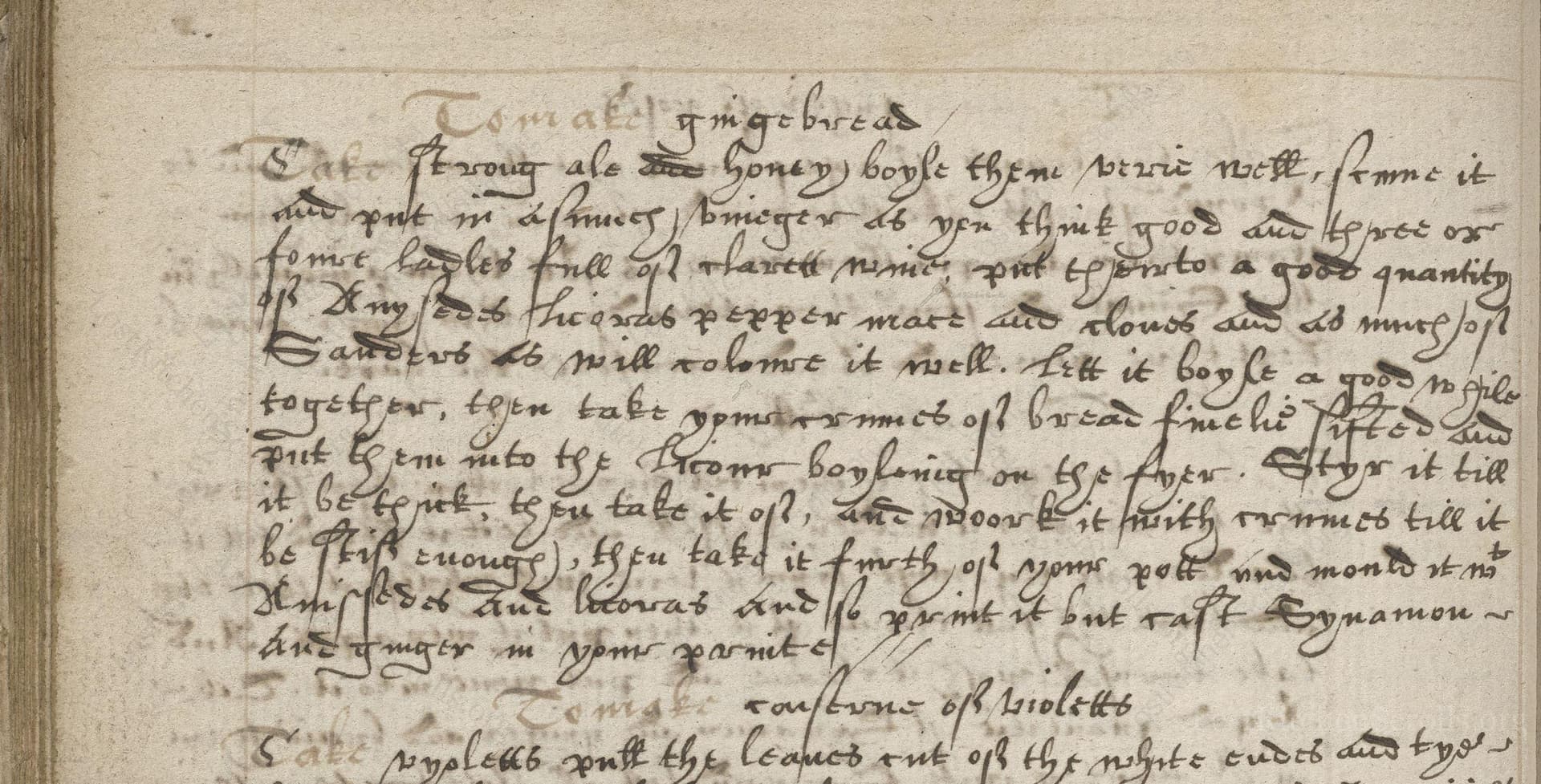To Make Gingerbread
From the treasured pages of Certain profitable and well experienced collections for making conserve of fruits
Written by Nicholas Webster

To Make Gingerbread
"Take honey & boyle them, skim it well, then take ginger as you think good and spices or rather mixe, put them to a good quantitie with pepper mace and cloves and so much of them as will coloure it well. Lett it boyle a good while, then take some crummes of bread finelie grated and putt in to it from boyling on the fyer. Styr it till it be thick, and season it with ramnes till you take it from of your pott and mould it in paste and so print it but cast synamon upon it in your garnished box."
Note on the Original Text
The recipe is written in early modern English, with loose spelling ('boyle', 'mixe', 'coloure'), scant punctuation, and minimal quantities—relying on the cook's experience. The directions are sequential but assume the reader already knows basic cooking methods like skimming boiled honey and handling breadcrumbs. Details such as 'as will coloure it well' or 'as you think good' signal the period's flexible approach, guided by personal taste, available ingredients, and the appearance of the mixture.

Title
Certain profitable and well experienced collections for making conserve of fruits (1650)
You can also click the book image above to peruse the original tome
Writer
Nicholas Webster
Era
1650
Publisher
Unknown
Background
Step back to the bustling kitchens of mid-17th century England with this flavorful collection by Nicholas Webster. Savory secrets, age-old recipes, and period culinary wisdom await in this masterfully penned volume—a true feast for culinary history enthusiasts.
Kindly made available by
Folger Shakespeare Library
This gingerbread recipe is drawn from a 17th-century English manuscript, dating to around 1650, when sugar was costly and honey was the dominant sweetener. Such recipes were often cherished as both treat and medicine: ginger and spices, imported at great expense, were prized for their supposed warming and digestive properties. Making spiced honey-bread treats was a festive activity, especially around holidays. Recipes like this one capture the transition from earlier, dense honeyed confections toward the more recognizably 'cake-like' gingerbread we enjoy today. The printing or moulding of gingerbread points to a tradition of elaborate presentation and ritual gifting.

In the 17th century, the cook would have used an open hearth or a wood- or coal-fired stove, managing temperature by moving the pot closer or further from the heat. A simple metal or earthenware pot sufficed for boiling honey; wooden spoons were used for stirring. Bread would be grated with a hand grater, and the paste kneaded on a wooden board. For shaping, wooden gingerbread moulds, carved with festive or symbolic figures, and tin boxes ('garnished box') were used for pressing and storing the sweets.
Prep Time
10 mins
Cook Time
15 mins
Servings
8
We've done our best to adapt this historical recipe for modern kitchens, but some details may still need refinement. We warmly welcome feedback from fellow cooks and culinary historians — your insights support the entire community!
Ingredients
- 2 cups honey
- 2 teaspoons ground ginger (or to taste)
- 1 teaspoon ground black pepper
- 1 teaspoon ground mace (substitute: nutmeg if mace unavailable)
- 1 teaspoon ground cloves
- 7 ounces white bread, crusts removed and finely grated
- 1 tablespoon ground cinnamon (for dusting)
Instructions
- Begin by gently heating 2 cups of good-quality honey in a saucepan.
- Skim off any foam that forms.
- Add 2 teaspoons ground ginger (adjust to taste), 1 teaspoon each of ground black pepper, ground mace, and ground cloves.
- The spices should be added generously, enough to darken the honey and infuse it with a pronounced aroma—aim for about 3 tablespoons in total.
- Allow the spiced honey to simmer gently for 10–15 minutes, stirring occasionally.
- Meanwhile, finely grate 7 ounces of white bread, removing the crusts to create soft breadcrumbs.
- Once the honey is richly aromatic, remove it from the heat and quickly stir in the breadcrumbs, mixing well until a thick, cohesive paste forms.
- Let the mixture cool slightly, then knead it by hand on a clean surface, dusted with a little extra breadcrumb if needed.
- Mould the paste into shapes of your choosing, or press into decorative moulds for traditional effect.
- To finish, dust the gingerbread with ground cinnamon and let it set in a covered container.
Estimated Calories
185 per serving
Cooking Estimates
It takes about 10 minutes to prepare the ingredients and workspace, and 15 minutes to cook the spiced honey and combine everything. Each serving has around 185 calories, and this recipe makes 8 servings.
As noted above, we have made our best effort to translate and adapt this historical recipe for modern kitchens, taking into account ingredients nowadays, cooking techniques, measurements, and so on. However, historical recipes often contain assumptions that require interpretation.
We'd love for anyone to help improve these adaptations. Community contributions are highly welcome. If you have suggestions, corrections, or cooking tips based on your experience with this recipe, please share them below.
Join the Discussion
Rate This Recipe
Dietary Preference
Culinary Technique

Den Bockfisch In Einer Fleisch Suppen Zu Kochen
This recipe hails from a German manuscript cookbook compiled in 1696, a time whe...

Die Grieß Nudlen Zumachen
This recipe comes from a rather mysterious manuscript cookbook, penned anonymous...

Ein Boudain
This recipe comes from an anonymous German-language manuscript cookbook from 169...

Ein Gesaltzen Citroni
This recipe, dating from 1696, comes from an extensive anonymous German cookbook...
Browse our complete collection of time-honored recipes



